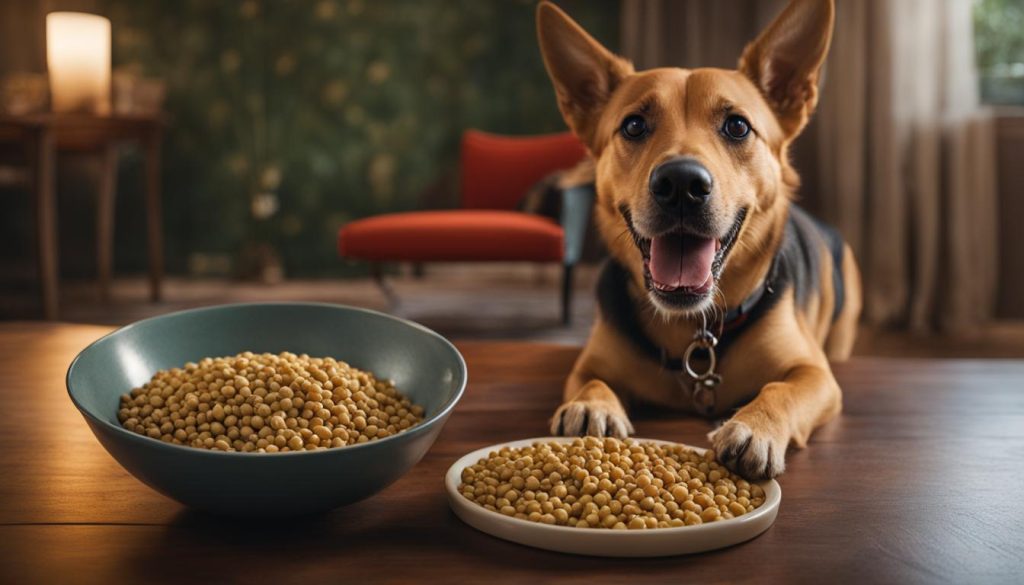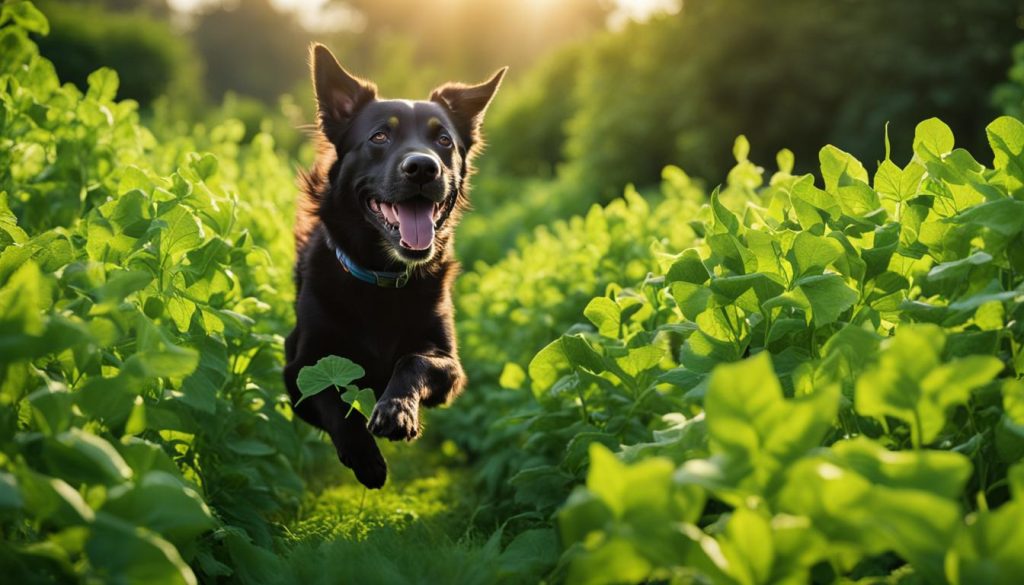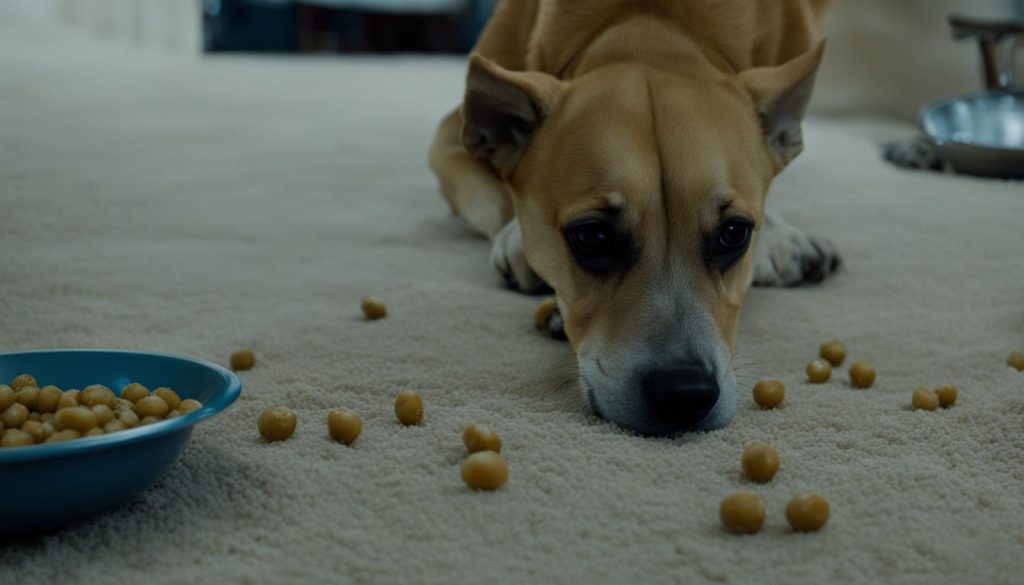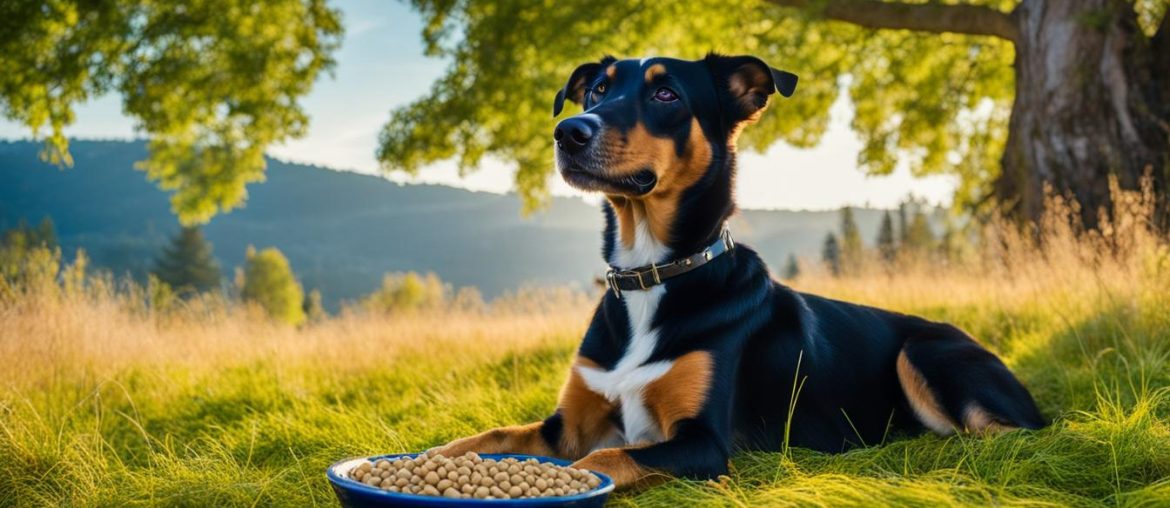Garbanzo beans, also known as chickpeas, are a popular legume enjoyed by many people. But can dogs eat garbanzo beans too? As a professional journalist, I dive into the topic to provide you with the information you need to know about feeding garbanzo beans to your furry friends.
Garbanzo beans can be a healthy and nutritious addition to a dog’s diet. They are packed with protein, fiber, iron, magnesium, selenium, and vitamin B, making them a beneficial ingredient for canine nutrition. However, it’s important to feed them in moderation to avoid any potential digestive issues.
When introducing garbanzo beans to your dog’s diet, it’s essential to rinse canned chickpeas to remove excess salt. Additionally, it’s best to avoid feeding dogs processed chickpea products like hummus, as they may contain harmful ingredients such as high levels of fat, seasoning, onion, garlic, and citric acid.
In this article, I will discuss the health benefits of garbanzo beans for dogs, how to feed them in moderation, and the risks associated with overfeeding. I will also address common questions, such as whether dogs can eat canned chickpeas and the difference between garbanzo beans and chickpeas. Let’s dive in and explore the world of garbanzo beans and dogs!
Key Takeaways:
- Garbanzo beans can be a healthy addition to a dog’s diet, providing protein, fiber, vitamins, and minerals.
- It’s important to feed garbanzo beans in moderation to avoid digestive issues.
- Avoid feeding dogs processed chickpea products like hummus, as they may contain harmful ingredients.
- Canned chickpeas can be fed to dogs after rinsing to remove excess salt.
- Garbanzo beans can be served cooked, as part of pre-made kibble, or even as tasty homemade treats.
Are Chickpeas Good for Dogs?

Chickpeas, also known as garbanzo beans, offer several health benefits for dogs. They are a natural and nutritious ingredient that can be included in their diet. Chickpeas provide essential nutrients such as protein, fiber, iron, magnesium, selenium, and vitamin B, which support overall canine nutrition. They are often included in dog food as a grain alternative and can be fed to dogs in cooked form or as part of pre-made kibble.
“Chickpeas provide protein for muscle growth, fiber for digestion, iron for energy, magnesium for metabolic activity, selenium for immune functioning, and vitamin B for healthier hair and skin.”
“Chickpeas provide protein for muscle growth, fiber for digestion, iron for energy, magnesium for metabolic activity, selenium for immune functioning, and vitamin B for healthier hair and skin.”
Feeding dogs chickpeas in moderation is key to ensure their optimal health. They can be incorporated into their meals as a protein supplement or included in pre-made kibble that contains the right quantities of chickpeas. However, it’s important to avoid feeding dogs processed chickpea products like hummus. These products often contain high levels of fat, seasonings, onion, garlic, and citric acid, which can be harmful to a dog’s digestive system.
| Benefits of Chickpeas for Dogs | Risks of Chickpeas for Dogs |
|---|---|
|
|
To summarize, chickpeas are a healthy choice for dogs when fed in moderation. They offer several health benefits and can be a suitable addition to their diet. However, it’s important to avoid overfeeding and feeding processed chickpea products. Always monitor your dog’s response to chickpeas and consult with a veterinarian before making any significant changes to their diet.
Feeding Chickpeas to Dogs in Moderation

When it comes to feeding garbanzo beans, or chickpeas, to dogs, moderation is key. While these legumes offer numerous health benefits, it’s important to avoid overfeeding to prevent digestive issues. Here are some important points to keep in mind when incorporating chickpeas into your dog’s diet:
- Use as a protein supplement: Cooked chickpeas can be added to your dog’s meals as a protein supplement. They provide an additional source of protein and can help keep your dog feeling satisfied.
- Choose pre-made kibble: Opt for pre-made kibble that already contains the right amount of chickpeas. This ensures your dog gets the benefits without the risk of overfeeding. Look for high-quality brands that prioritize wholesome ingredients.
- Avoid excessive quantities: Feeding too many chickpeas can lead to digestive issues, such as constipation or diarrhea. It’s important to feed them in moderation and monitor your dog’s response to ensure they tolerate them well.
By following these guidelines, you can safely incorporate chickpeas into your dog’s diet and provide them with the nutritional benefits they offer. Remember to consult with your veterinarian before making any significant changes to your dog’s diet, especially if they have any existing health conditions.
Chickpea Nutritional Profile
| Nutrient | Amount per 100g |
|---|---|
| Protein | 19g |
| Fiber | 5g |
| Iron | 2.9mg |
| Magnesium | 48mg |
| Selenium | 4.8µg |
| Vitamin B | 0.6mg |
Avoiding Processed Chickpea Products
When it comes to feeding your dog garbanzo beans, it’s important to be cautious about the type of products you offer. While plain cooked chickpeas can provide essential nutrients, processed chickpea products like hummus should be avoided. These products often contain high levels of fat, seasonings, onion, garlic, and citric acid, which can be harmful to a dog’s digestive system. In fact, some of these ingredients can even be toxic to dogs.
Feeding your dog hummus can lead to digestive issues such as upset stomach, diarrhea, or even pancreatitis. The high fat content and seasonings can put strain on the dog’s digestive system, causing discomfort and potential health problems. It’s best to stick to plain cooked chickpeas or pre-made kibble that contains chickpeas, ensuring your dog gets the nutritional benefits without the added risks.
Remember, processed chickpea products like hummus are designed for human consumption and may have other ingredients that outweigh the health benefits of the chickpeas for dogs. It’s always better to consult with a veterinarian before introducing any new food to your dog’s diet. They can provide specific guidance based on your dog’s individual needs and health conditions.
“Feeding your dog hummus can lead to digestive issues such as upset stomach, diarrhea, or even pancreatitis.”
| Processed Chickpea Products | Risks |
|---|---|
| Hummus |
|
| Other processed chickpea snacks |
|
Can Dogs Eat Canned Chickpeas?
Many dog owners wonder if it’s safe to feed their furry friends canned chickpeas. The short answer is yes, dogs can eat canned chickpeas. However, there are a few important considerations to keep in mind to ensure your dog’s safety and well-being.
When choosing canned chickpeas for your dog, opt for low sodium options. Excess salt can be harmful to dogs, so it’s essential to rinse the chickpeas thoroughly to remove any excess salt before feeding them to your dog. Additionally, read the label carefully to check for any additional preservatives or ingredients that could be potentially harmful to your dog’s digestive system. It’s always best to choose canned chickpeas with fewer ingredients.
While canned chickpeas can be a healthy addition to your dog’s diet, it’s important to feed them in moderation. Treat canned chickpeas as a special treat or topping rather than a regular part of your dog’s meals. As with any new food, introduce chickpeas gradually and monitor your dog’s response. If you notice any digestive issues or adverse reactions, it’s best to consult with your veterinarian.
| Benefits of Canned Chickpeas for Dogs | Risks of Feeding Canned Chickpeas to Dogs |
|---|---|
|
|
“Canned chickpeas can be a nutritious and tasty treat for your dog, but it’s important to feed them in moderation and choose low sodium options. Always monitor your dog’s response and consult with your veterinarian if you have any concerns.”
Garbanzo Beans vs Chickpeas

Garbanzo beans and chickpeas are two names for the same ingredient. They offer the same health benefits for dogs. Chickpeas, or garbanzo beans, provide fiber for digestion and bowel health. While they are not easily digested in large quantities, the right amount can help regulate bowel movements and promote a healthier digestive tract. Many dog food manufacturers use chickpeas as an alternative to grains in their products.
Comparing Garbanzo Beans and Chickpeas
| Property | Garbanzo Beans | Chickpeas |
|---|---|---|
| Common Name | Garbanzo Beans | Chickpeas |
| Nutritional Benefits | High in fiber, protein, vitamins, and minerals | High in fiber, protein, vitamins, and minerals |
| Digestibility | Not easily digested in large quantities | Not easily digested in large quantities |
| Common Uses | Alternative to grains in dog food | Alternative to grains in dog food |
As you can see from the table above, there is no significant difference between garbanzo beans and chickpeas when it comes to their nutritional benefits and digestibility for dogs. They both offer a good source of fiber, protein, vitamins, and minerals. However, they are not easily digested in large quantities, so moderation is key when incorporating them into your dog’s diet.
Many dog food manufacturers have recognized the nutritional benefits of chickpeas and have started including them as an alternative to grains in their products. This is because chickpeas provide dogs with the necessary fiber for digestion and bowel health. They can help regulate bowel movements and promote a healthier digestive tract for your furry friend.
Overall, whether you call them garbanzo beans or chickpeas, these legumes can be a beneficial addition to your dog’s diet when fed in moderation. They offer fiber, protein, vitamins, and minerals that support your dog’s overall health and well-being. Just remember to introduce them gradually and monitor your dog’s response to ensure there are no adverse reactions.
Best Ways to Serve Chickpeas to Dogs

Chickpeas, or garbanzo beans, can be served to dogs in various ways to provide them with a healthy and nutritious addition to their diet. Here are some of the best ways to serve chickpeas to dogs:
1. In Pre-Made Kibble:
Many dog food manufacturers include chickpeas as an alternative to grains in their products. Look for pre-made kibble that contains chickpeas in the right quantities to ensure your dog gets the benefits without the risk of overfeeding. Combining chickpeas with meat protein in kibble ensures a balanced diet for dogs.
2. Roasted and Dried:
Roasting and drying chickpeas can turn them into tasty treats or snacks for walks and training sessions. Simply rinse canned chickpeas, dry them thoroughly, and spread them on a baking sheet. Roast them in the oven at a low temperature until they are crunchy. Let them cool before offering them to your dog as a delicious and healthy reward.
3. Ground into Flour:
If you enjoy baking homemade dog treats for your furry friend, you can grind chickpeas into flour and use it as an ingredient. Combine the ground chickpea flour with other dog-friendly ingredients like peanut butter, pumpkin, or sweet potato to create tasty and nutritious treats. Remember to avoid adding any seasonings, sugars, or harmful ingredients.
With these different ways to serve chickpeas to dogs, you can incorporate them into your pet’s diet and provide them with the health benefits they offer. Remember to start with small quantities and monitor your dog’s response to ensure they tolerate chickpeas well.
Benefits of Garbanzo Beans for Dogs

Garbanzo beans, also known as chickpeas, offer a range of health benefits for dogs. These nutrient-packed legumes provide dogs with protein, fiber, vitamins, and minerals that promote overall well-being. Let’s explore the specific benefits of garbanzo beans and their impact on canine nutrition.
1. Protein for Muscle Growth
Garbanzo beans are a rich source of plant-based protein, which is essential for muscle growth and repair in dogs. Protein supports the development of strong and healthy muscles, providing dogs with the energy they need for an active lifestyle.
2. Fiber for Digestion
The high fiber content in garbanzo beans aids digestion in dogs. Fiber helps regulate bowel movements, promoting a healthy digestive tract and preventing issues such as constipation. It also supports optimal nutrient absorption and can contribute to maintaining a healthy weight.
3. Vitamins and Minerals for Overall Health
Garbanzo beans are packed with essential vitamins and minerals that contribute to a dog’s overall health. These include iron for energy production, magnesium for metabolic activity, selenium for immune functioning, and vitamin B for healthier hair and skin.
4. Low in Calories
Garbanzo beans are a nutritious and low-calorie food option for dogs. They can be included in a balanced diet without contributing excessive calories, making them a suitable choice for dogs who need to manage their weight or have specific dietary restrictions.
| Benefits | Summary |
|---|---|
| Protein for Muscle Growth | Supports muscle development and repair |
| Fiber for Digestion | Aids in digestion and promotes regular bowel movements |
| Vitamins and Minerals | Contributes to overall health and well-being |
| Low in Calories | Nutritious option without excessive calories |
When incorporating garbanzo beans into your dog’s diet, it’s important to do so in moderation. While they offer numerous health benefits, feeding an excessive amount of garbanzo beans can lead to digestive issues. Additionally, avoid feeding dogs processed chickpea products like hummus, as they may contain ingredients that can be harmful to dogs. Always consult with a veterinarian before making any significant changes to your dog’s diet.
“Garbanzo beans are a nutritious addition to a dog’s diet, providing protein, fiber, vitamins, and minerals. They support muscle growth, aid digestion, and contribute to overall health. However, like any food, it’s important to feed garbanzo beans in moderation and avoid processed chickpea products.”
Including garbanzo beans as part of a balanced diet can be a beneficial way to provide your dog with essential nutrients. However, it’s crucial to consider your dog’s individual needs and consult with a veterinarian to ensure their dietary requirements are met. By incorporating garbanzo beans responsibly, you can support your dog’s overall health and well-being.
Risks of Feeding Garbanzo Beans to Dogs

While garbanzo beans, or chickpeas, can be a healthy addition to a dog’s diet, there are some risks associated with feeding them to dogs. It’s important to be aware of these risks and take precautions to ensure your dog’s well-being.
1. Digestive Issues:
Feeding too many garbanzo beans to your dog can lead to digestive issues such as bloating, gas, or loose stools. This is because garbanzo beans, like other legumes, contain complex carbohydrates that can be difficult for dogs to digest in large quantities. It’s important to feed garbanzo beans in moderation and monitor your dog’s response to avoid any gastrointestinal upset.
2. Allergic Reactions:
Some dogs may be allergic to garbanzo beans. If you notice any signs of an allergic reaction after feeding your dog garbanzo beans, such as itching, swelling, or difficulty breathing, it’s important to stop feeding them immediately and consult with your veterinarian. They can help determine if your dog has a garbanzo bean allergy and recommend alternative food options.
3. High Caloric Content:
Garbanzo beans are relatively high in calories compared to other dog-friendly vegetables. Feeding your dog too many garbanzo beans can contribute to weight gain and obesity. It’s important to take into account your dog’s overall calorie intake and adjust their portion size accordingly. As always, it’s best to consult with your veterinarian to determine the appropriate amount of garbanzo beans to include in your dog’s diet.
4. Nutritional Imbalance:
While garbanzo beans are a good source of protein, fiber, and other nutrients, they should not be the sole source of nutrition for your dog. It’s important to feed a balanced diet that includes a variety of proteins, vegetables, and grains, as recommended by your veterinarian. Too much reliance on garbanzo beans can lead to nutritional imbalances and deficiencies in your dog’s diet.
| Risks of Feeding Garbanzo Beans to Dogs |
|---|
| Digestive Issues |
| Allergic Reactions |
| High Caloric Content |
| Nutritional Imbalance |
How to Prepare Garbanzo Beans for Dogs
When it comes to serving garbanzo beans, or chickpeas, to your furry friend, there are a few key considerations to keep in mind. Proper preparation is essential to ensure the beans are safe and beneficial for your dog. Here’s how to prepare garbanzo beans for dogs:
- Start by choosing fresh or canned garbanzo beans. If using canned beans, be sure to select low sodium options and rinse them thoroughly to remove excess salt.
- Next, you can cook the beans by boiling them in water until they are soft and easily mashed with a fork. Avoid adding any seasonings or other ingredients that may be harmful to dogs.
- Once the beans are cooked, you can serve them to your dog in a few different ways. One option is to mash them up and mix them into your dog’s kibble as a protein-packed supplement.
- You can also use garbanzo beans as a healthy topping or mix them into homemade dog treats. Simply blend or mash the beans until they reach a smooth consistency and incorporate them into your favorite dog-friendly recipes.
Remember, while garbanzo beans can be a nutritious addition to your dog’s diet, it’s important to feed them in moderation. Too many beans may lead to digestive issues such as bloating or diarrhea. Always monitor your dog’s response to any new food and consult with your veterinarian if you have any concerns or questions about your dog’s diet.
By following these simple steps, you can safely incorporate garbanzo beans into your dog’s meals and treats, providing them with a tasty and healthy source of protein, fiber, and essential nutrients.
Other Legumes Dogs Can Eat
Aside from garbanzo beans, there are several other legumes that can be safely included in a dog’s diet. These legumes offer similar health benefits and can provide variety in your dog’s meals:
- Green beans: Rich in vitamins and minerals, green beans are low in calories and can be a great source of fiber for dogs. They can be served raw, steamed, or boiled, but avoid adding any seasonings or oils.
- Black beans: Packed with protein and fiber, black beans can be a nutritious addition to your dog’s diet. Make sure to thoroughly cook them and avoid adding any salt or seasonings.
- Lima beans: Lima beans are a good source of protein, iron, and potassium. They can be boiled or steamed and served in moderation to avoid any digestive issues.
- Pinto beans: High in fiber, pinto beans are a great option for promoting healthy digestion in dogs. They can be cooked and mashed before being added to your dog’s meals.
When introducing these legumes to your dog’s diet, it’s important to start with small amounts and monitor their response. Some dogs may have sensitivities or allergies to certain legumes, so it’s always best to consult with your veterinarian before making any major changes to their diet. Additionally, legumes should never comprise the majority of your dog’s meals and should always be served alongside a balanced diet of protein, carbohydrates, and fats.
Table: Comparison of Dog-Friendly Legumes
| Legume | Nutritional Benefits | Serving Recommendations |
|---|---|---|
| Garbanzo Beans | Protein, fiber, vitamins, minerals | Plain cooked or included in pre-made kibble |
| Green Beans | Vitamins, minerals, fiber | Raw, steamed, or boiled, without seasonings or oils |
| Black Beans | Protein, fiber | Thoroughly cooked, avoid salt and seasonings |
| Lima Beans | Protein, iron, potassium | Boiled or steamed, served in moderation |
| Pinto Beans | Fiber | Cooked and mashed, added to meals |
Remember, each dog is unique, and it’s important to consider their specific dietary needs and any potential allergies or sensitivities they may have when introducing new foods. With proper moderation and guidance from your veterinarian, legumes can be a healthy and nutritious addition to your dog’s diet.
Wrapping Up
To summarize, garbanzo beans, or chickpeas, can be a valuable addition to a dog’s diet, offering several health benefits. These legumes provide dogs with essential nutrients such as protein, fiber, vitamins, and minerals, which support overall health and well-being. However, it is crucial to feed garbanzo beans in moderation to avoid any potential digestive issues.
While garbanzo beans are generally safe for dogs, it is important to avoid feeding them processed chickpea products like hummus, as they often contain high levels of fat, seasoning, and potentially harmful ingredients. It is always best to choose plain cooked chickpeas or pre-made kibble that already includes chickpeas as part of a nutritious and balanced dog diet.
Before making any changes to your dog’s diet or introducing garbanzo beans, it is advisable to consult with a veterinarian. They can provide personalized guidance based on your dog’s specific dietary needs and ensure that garbanzo beans are a suitable addition to their overall meal plan. Monitoring your dog’s response to chickpeas is essential to ensure they are well-tolerated and do not lead to any adverse effects.
In summary, when fed in moderation and under professional guidance, garbanzo beans can be a healthy and beneficial ingredient in a dog’s diet. They offer important nutrients and can contribute to overall wellness. However, it is crucial to prioritize your dog’s individual needs and consult with a veterinarian to ensure their dietary requirements are met.
FAQ
Can dogs eat garbanzo beans?
Yes, garbanzo beans, also known as chickpeas, can be a healthy and nutritious addition to a dog’s diet when fed in moderation.
Are chickpeas good for dogs?
Yes, chickpeas provide protein, fiber, vitamins, and minerals that support overall health and well-being in dogs.
How should I feed chickpeas to my dog?
Chickpeas can be fed in cooked form as a protein supplement or included in pre-made kibble that contains the right quantities. It’s important to feed them in moderation.
Can dogs eat processed chickpea products like hummus?
It’s best to avoid feeding dogs processed chickpea products like hummus as they often contain ingredients that can be harmful to a dog’s digestive system.
Can dogs eat canned chickpeas?
Yes, dogs can eat canned chickpeas, but it’s important to choose low sodium options and rinse them thoroughly to remove excess salt.
What is the difference between garbanzo beans and chickpeas?
Garbanzo beans and chickpeas are two names for the same ingredient. They offer the same health benefits for dogs.
How can I serve chickpeas to my dog?
Chickpeas can be included as part of pre-made kibble, roasted and dried as a treat or snack, or ground down to flour form to bake doggy treats.
What are the benefits of garbanzo beans for dogs?
Garbanzo beans provide dogs with essential nutrients such as protein, fiber, vitamins, and minerals that support overall health and well-being.
What are the risks of feeding garbanzo beans to dogs?
Feeding too many garbanzo beans can lead to digestive issues such as bloating, gas, or loose stools. It’s important to feed them in moderation.
How should I prepare garbanzo beans for my dog?
Garbanzo beans can be cooked plain, mashed up and mixed into a dog’s kibble, or used in baking dog-friendly treats.
Can dogs eat other legumes?
Yes, dogs can safely consume other legumes such as green beans, black beans, lima beans, and pinto beans.






